Sound Designing with the Mega and
ADAP II Sound System
BY MICHAEL R. PERRY
Emmy nominated (Beauty and the Beast) sound editor Scott Gershin is making famous Atari's Mega and Hybrid Arts' ADAP II. His latest use of this equipment was for the new Oliver Stone film "Born on the Fourth of July," starring Tom Cruise. START sent contributor Michael R. Perry to talk with Gershin about his amazing work.
The 11 rookies had never before endured anything like the aural assault that now surrounded them. The staccato burst of close-range gunfire from an M14 rattled the greenhorns to their bones. A Huey attack chopper - one of ours -whirred overhead with a deafening roar, but something was clearly wrong. A whiny screech coming from the chopper indicated danger and the Huey disappeared behind a row of trees. "Mayday! Mayday!" came the report from the pilot's radio, then his panicked dispatch was abruptly replaced by the hiss of static. A gut-wrenching explosion was chased by the crackle of flames from behind the trees and he was down. The cacophony of war was everywhere. The leader turned to one of the group and smiled. "Welcome to NAMM, kid."
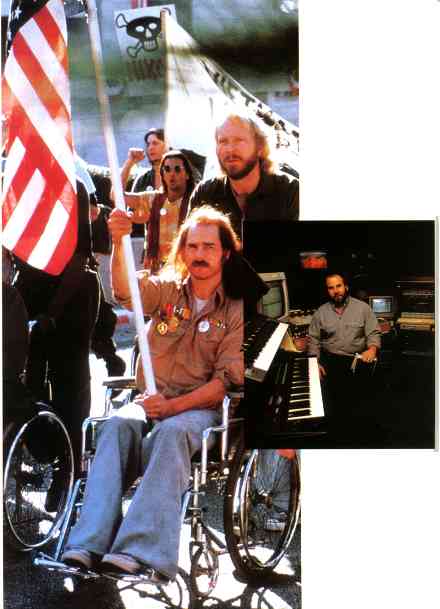
"Born on the Fourth of
July," starring Tom Cruise (left), was nominated
for an Oscar for Best
Picture. Scott Gershin (above) built the soundtrack
using a MgaST and the
ADAP II sound system.
Southeast Asia? Guess again. NAMM is the National Association of Music Merchants' semi-annual trade show, and the battle sounds were from the soundtrack of Oliver Stone's Academy Award nominated "Born on the Fourth of July," starring Tom Cruise. Sound editor Scott Martin Gershin, who received an Emmy nomination for his work on "Beauty and the Beast," created the richly textured movie soundtrack virtually from scratch using a Mega and Hybrid Arts' ADAP II sound-manipulation system. The end result is a motion-picture experience that puts the viewer directly into the midst of battle. At the NAMM show, Gershin was on hand in the Atari booth to give demonstrations of his work.
Before the value and utility of the Mega-based system can be appreciated, it is first necessary to understand the challenge of motion picture sound editing. With most movies, particularly those shot on location (rather than on a soundproof set), the sound recorded during filming is of limited use. During the demonstration, Gershin showed a clip from "Born Ofl the Fourth of July" as it appeared before any serious sound work was done.
In the "before" sequence, the visual editing was tight and, as would be expected from an Oliver Stone film, the cinematography and direction were superb. Yet the scene still felt disjointed and strange. There was no helicopter, no voices on the radio, no roar to accompany the explosion. The shots from Tom Cruise's gun were out of synchronization and muffled; background noises came and went randomly, including an inappropriate hum from a fan that was used to blow dust during filming; and Cruise's dialogue was barely audible.
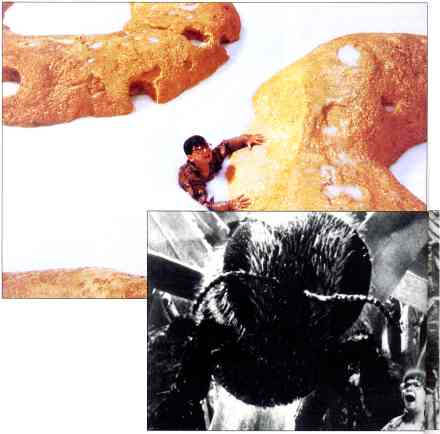
Gershin created totally
new sounds for "Honey I Shrunk the Kids,"
(above) including insect
voices. A bee terrorizes one of the shrunken kids (right).
Gershin stopped the videotape. "As you can hear, there were significant problems with the original sound," he said, smiling. "Actually, we got rid of all of it." Incredible as it may sound, Gershin chose to throw away the sound recorded during production and begin again from scratch, building up the audio one sound effect at a time, "everything from the crickets to the helicopters."
Motion-Picture Sound Editing
Gershin's dilemma was not unique; as often as not the sound recorded
on location is useful only as a reference. The old-fashioned way to build
a soundtrack required miles of magnetic tape, the diligence of an assembly
line worker and the patience of a saint. Choosing a sound required threading
up magnetic tapes and playing them one at a time to find the right effect.
Each chosen sound had to be transferred to magnetic film (35-mm film coated
with magnetic oxide), and painstakingly spliced into bulky reels, each
reel containing one track of sound. Twenty-four tracks generated 24 reels
of magnetic film.
If a gunshot was needed 100 times, it had to be transferred to magnetic film and spliced 100 times. The difficulty was aggravated by the fact that sound editing is one of the last processes in film production. When the release date is fixed and filming goes two weeks over schedule, the sound editor might have two weeks less to complete his task.
As a result, the sound editor's life seems to consist of one stressful deadline after another. "Sleep is for Sissies" reads the graffiti in one postproduction company's bathroom. The time to experiment and try new approaches was a rare luxury; getting the job done on time was often all a sound editor hoped to do.
The profession of sound editing was ready for some changes. Hollywood has been described as a continual struggle between artists and businessmen. The sound editors, as artists, desired tools that would let them work faster and thus have more time for experimentation, creativity and the pursuit of excellence. The producers, being businessmen, were constantly looking for ways to do things cheaper and more efficiently. The ADAP II is the rare commodity that can please both the artist and businessman.
The ADAP II System and
How It was Used
ADAP is an abbreviation for Analog Digital Audio Processor. Although
ADAP was originally developed for music studios, sound editors and others
in the movie post-production business saw the possibilities of this powerful
tool and Hybrid Arts responded with ADAP II.
Hybrid Arts describes the ADAP II as "the direct-to-hard-disk digital recorder and editor." Gershin cuts through the hype and simply calls it "a word processor for audio." ADAP II takes over much of the grueling, repetitive work of sound editing without compromising creativity.
For "Born on the Fourth of July," Gershin used many of the capabilities of the system. To begin with, rather than record sounds on tape, ADAP II digitizes sounds and stores them as files on the Mega, available instantly at the click of a mouse. "On Fourth of July, we had over 300 gunshot sounds," Gershin explained. "If Oliver Stone wanted to hear something, I could click the mouse and play him any of them, instead of threading up magnetic tapes. If he liked a particular gunshot, I could add it to a track right then and there."
For the battle scene described above, sound effects had to be added one at a time. Depending on the sequence, there may be dozens of sounds playing simultaneously. "Building tracks" is the process of finding appropriate sound effects for each event and synchronizing them to a picture.
An ADAP II setup provides a convenient and intuitive way to build tracks. The edited picture portion of the movie is dubbed to videotape and SMPTE code is recorded on the videocassette. SMPTE stands for Society of Motion Picture and Television Engineers; professionals pronounce it "simpty." SMPTE code is to video and film what ASCII is to computers: an industry standard that provides a common reference. Simply put, SMPTE code assigns a unique number to every picture frame of a videotape, 30 frames a second.
A minimal ADAP II sound-editing suite has a videotape player, a Mega equipped with the ADAP II software and hardware, and a multitrack recorder. When the videotape is played, the SMPTE time code is read by the ADAP II system and the multitrack recorder and everything stays in synchronization.
The videotape that carries SMPTE code is the master telling all other machines where they should be; the multitrack recorder and the ADAP II are slaves marching in step with the video.
Gershin's studio is much more complete: he has two Mega 4s, rack mounted with color monitors; two fully configured ADAP II systems; a 380MB hard drive; a 77MB hard drive; a Megafile-44, 44MB removable hard drive; an ICD 154MB tape backup; a 24-track Dolby SR machine; a full theatrical speaker system; a digital audio tape deck; and "eight MIDI keyboards and a couple dozen signal processors," he boasts. It may sound like the Starship Enterprise, but all the equipment is used heavily and constantly.
To build tracks, the editor simply brings up the ADAP II "cue sheet" screen on his Mega monitor and plays the videotape. On the ST is a screen showing four columns: sound start, sound stop, a column for the file name of each sound effect and a column for comments. At each point where a sound effect is desired, the editor can notate the estimated starting point for the effect with the click of a mouse. Then, he can listen to various effects that are stored on the hard drive, until he finds the one that's best. The sound can be synchronized to the picture, and the picture and sound played back to check. If an adjustment is needed, moving the sound forward or back or replacing it is intuitive and very fast.
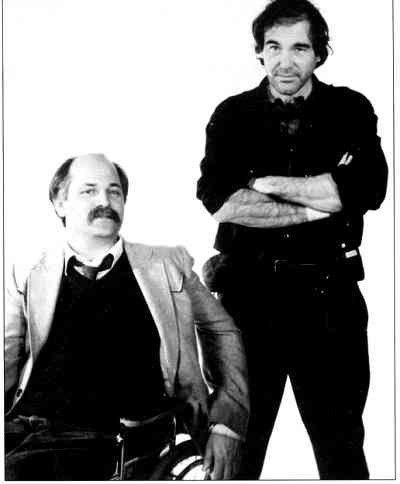
Ron Kovic (above, left)
is the Vietnam veteran whose autobiography,
"Born on the Fourth of
July," was made into the movie of the same
name by director Oliver
Stone (above, right). Tom Cruise (below)
was nominated for a Best
Actor Oscar for his portrayal of Kovic.
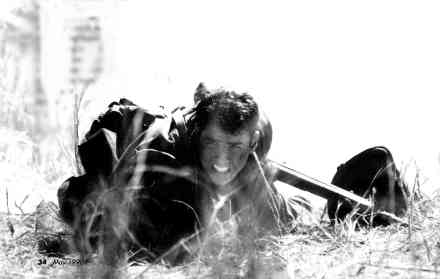
With this system, an experienced editor can find and place effects much faster than with old-fashioned magnetic film, scissors and splicing tape. The Mega/ADAP II can digitally store two tracks in its memory. When the two tracks are full, the editor copies them to the multitrack recorder and begins building two more SMPTE code and black hox4 keep the ADAP II, the videotape and the multitrack recorder in synchronization. A motion picture may have 50 or more soundeffects tracks, all of which can be created with the ADAP II, two at a time.
On "Born on the Fourth of July," the agility and speed of using the ADAP II to build tracks gave Gershin a luxury enjoyed by few sound editors the ability to experiment. After the rough cut described above, but before the movie was finished, the producers requested a "temp dub", which is essentially a quick-and-dirty temporary soundtrack used for intermediate purposes like studio screenings.
Ordinarily a temp dub is not very polished and contains only the bare minimum sound needed to tell story. For "Fourth of July," though, Gershin wanted to try out some slightly different approaches and created a much fuller sound mosaic than was required for the temp dub, using the extra time that the ADAP II system gave him. "The best way to do something new is to just do it, and not waste time talking about it," Gershin said, "Rather than talk about my ideas for the sound, I was able to demonstrate them in a relatively complete state al the temp dub." His artistic decisions were solid and director Oliver Stone was favorably impressed.
After the temp dub, Gershin buckled down for the long haul and added the many layers of sound that give Born on the Fourth of July its visceral impact. "At the end of the show, we had five gigabytes of sound, as well as five 24-track tapes per reel, for 16 reels. I wore two runners out just hauling tape." At the NAMM demo, Gershin showed what a sequence looked like finished. The battle came alive, thanks to Gershin's sound effects, the John Williams score and the efforts of other post-production craftspeople.
Other Projects
War movies may require explosions, gunfire and helicopter sounds, but
the real challenge to a sound editor is when a movie requires sounds that
no one has ever heard. That's what happened to Gershin on Disney's "Honey
I Shrunk The Kids."
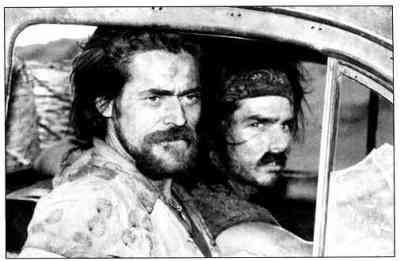
Willem Dafoe (left) and
Cruise (right) in a scene from "Born on
the Fourth of July."
"There were giant ants in that movie, but no one seemed to know just what they should sound like," Gershin said. "I said, 'just don't ask any questions and give me a couple days.' I went into a room and recorded my own voice, but ran it through a bunch of sound filters. I made four different versions: a silly ant, an angry ant, a happy ant and a normal ant." Using the speed of the ADAP II, Gershin cut together all four versions in just a few days. In the past such a luxury of options would have been unheard of on all but the most expensive movies.
A new feature offered for the ST that has made a buzz in the movie post-production business is the 44MB removable hard drive. Since digitally sampled sound eats up memory, ADAP II users fill up hard drives like everyone else fills up floppies. "The 44MB removable drive is very exciting," Gershin said. "It means you can carry around four minutes of digital stereo sound. For example, suppose you had a one-minute jingle for a commercial. You could have the digitally sampled stereo jingle, as well as a 45-second, 30-second and 15-second version, and all the sequenced tracks and the software to play them back on a single disk in your briefcase." Building tracks using digital audio is faster; the sound quality is better than or equal to anything currently available; and it saves money and lets artists try new ideas. What more could people ask for?
Standardization. Besides the ADAP II, there are other (mostly more expensive) digital audio systems and each stores sounds in similar, yet incompatible, ways. Gershin hopes to bring manufacturers together to create an industry standard, similar to the MIDI standard or the CD-ROM standards.
Additionally, Hybrid Arts hopes to release an upgrade soon that will let sounds sampled on Digital Audio Tape (DAT) be digitally transferred into the ADAP II. The ability to digitally record four tracks is in the distant future and they are also working on "compression" capabilities, i.e., the ability to speed up or slow down sounds without changing the pitch. Compression would be useful to turn a one-minute, 10-second song into a one-minute song without changing its key.
But even in its current state, the ADAP lI/Mega system is turning up in more and more post-production houses. Like other industries, the motion-picture business has a few leaders and many who just keep their heads above water. New products are introduced all the time, but most fall by the wayside - if it's not any better, no one wants it. Two of the best sound companies in Los Angeles have a large installed base of ADAP IIs. One company set up 10 stations based on the ADAP II. Movies as diverse as "Born on the Fourth of July," "Steel Magnolias," "National Lampoon's Christmas Vacation" and "Honey, I Shrunk The Kids" have used the ADAP II, as well as television shows like "MacGyver," "Beauty and the Beast" and "Murder She Wrote." Thanks to the elegant design of the ST and the hard work of the Hybrid Arts developers, the Mega and ADAP II have taken Hollywood by storm. And they're here to stay.
Michael R. Perry is head of CU Productions in Hollywood where be has produced over 100 music and Industrial videos. He is also a freelance writer who has published numerous magazine articles including "Screen Writing with WordPerfect on the ST" in the June 1989 issue of START.